Memory Performance: 16GB DDR3-1333 to DDR3-2400 on Ivy Bridge IGP with G.Skill
by Ian Cutress on October 18, 2012 12:00 PM EST- Posted in
- Memory
- G.Skill
- Ivy Bridge
- DDR3
One of the most important kits in this review is the DDR3-1600 kit for which G.Skill has supplied one of their RipjawsX range. This kit is of importance due to the close price differential to the DDR3-1333 kit ($5 difference), but also as generations of processors go forward we get an ever increasing suggested memory speed of those processors. Take the most recent AMD Trinity processor release for desktops – all but the low end processor supports 1866 MHz memory as the standard out of the box. Now we can be assured that almost all of the processors will do 2133 MHz, but as manufacturers raise that ‘minimum’ compliance barrier in their testing on their IMCs, the ‘standard’ memory kit has to be faster and come down in price also.
Visual Inspection
The RipjawsX kit we have uses a large heatsink design, with the top of the heatsink protruding 9.5mm above the module itself. As mentioned with the Ares DDR3-1333 kit, there are multiple reasons for why heatsinks are used, and pretty low on that list is for cooling. More likely these are placed initially for protecting which ICs are used in the kit from the competition (using a screwdriver and a heatgun to remove them usually breaks an IC on board), then also for aesthetics.
The heatsink for RipjawsX uses a series of straight lines as part of the look, which may or may not be beneficial when putting them into a system with a large air cooler. Here I put one module into a miniITX board, the Gigabyte H77N-WiFi, with a stupidly large and heavy air cooler, the TRUE Copper:
As we can see, the cooler would be great with the Ares kit, but not so much with the RipjawsX. The kit will still work in the memory slot like this, though for piece of mind I would prefer it to be vertical. As we will see with the TridentX (the 2400 MHz kit), sometimes having a removable top end heatsink helps.
JEDEC + XMP Settings
| G.Skill | |||||
| Kit Speed | 1333 | 1600 | 1866 | 2133 | 2400 |
| Subtimings | 9-9-9-24 2T | 9-9-9-24 2T | 9-10-9-28 2T | 9-11-10-28 2T | 10-12-12-31 2T |
| Price | $75 | $80 | $95 | $130 | $145 |
| XMP | No | Yes | Yes | Yes | Yes |
| Size | 4 x 4 GB | 4 x 4 GB | 4 x 4 GB | 4 x 4 GB | 4 x 4 GB |
|
|
|||||
| MHz | 1333 | 1600 | 1867 | 2134 | 2401 |
| Voltage | 1.500 | 1.500 | 1.500 | 1.650 | 1.650 |
| tCL | 9 | 9 | 9 | 9 | 10 |
| tRCD | 9 | 9 | 10 | 11 | 12 |
| tRP | 9 | 9 | 9 | 10 | 12 |
| tRAS | 24 | 24 | 28 | 28 | 31 |
| tRC | 33 | 33 | 37 | 38 | 43 |
| tWR | 10 | 12 | 14 | 16 | 16 |
| tRRD | 4 | 5 | 5 | 6 | 7/6 |
| tRFC | 107 | 128 | 150 | 171 | 313 |
| tWTR | 5 | 6 | 8/7 | 9/8 | 10/9 |
| tRTP | 5 | 6 | 8/7 | 9/8 | 10/9 |
| tFAW | 20 | 24 | 24 | 25 | 26 |
| tCWL | - | 7 | 7 | 7 | 7 |
| CR | - | 2 | 2 | 2 | 2 |



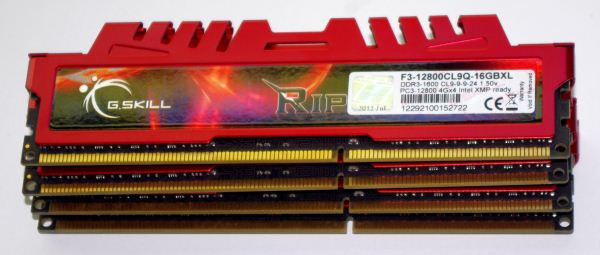
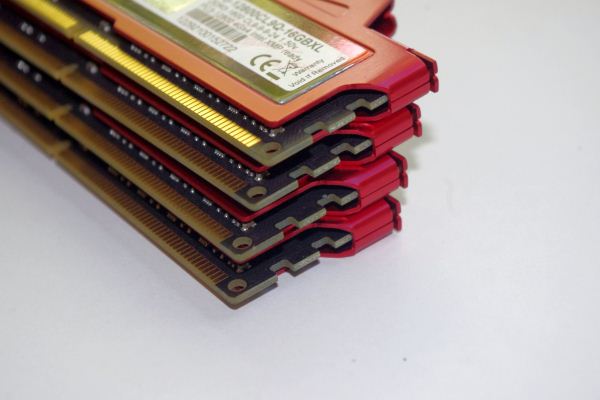
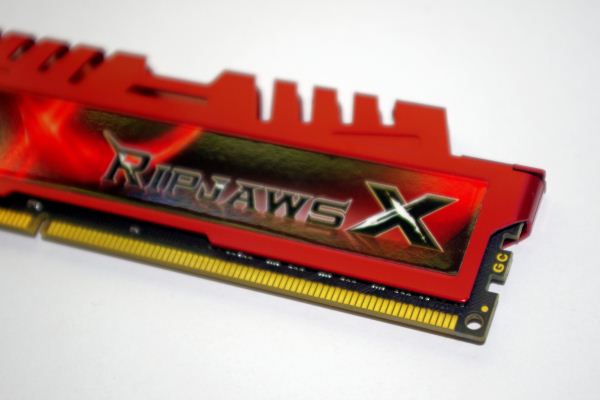


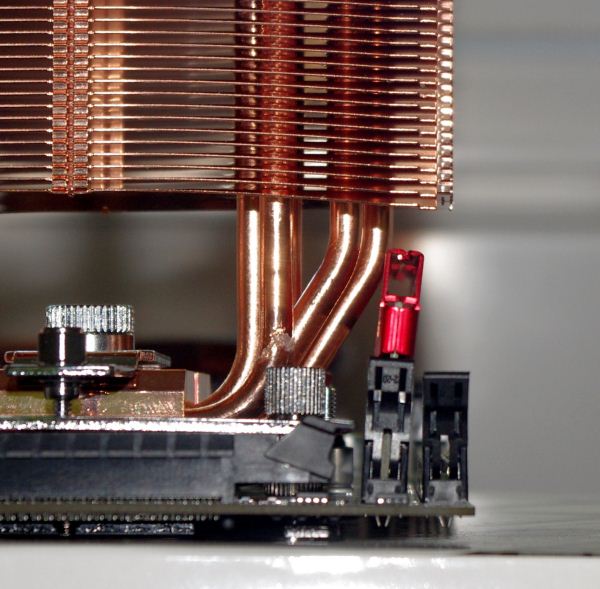






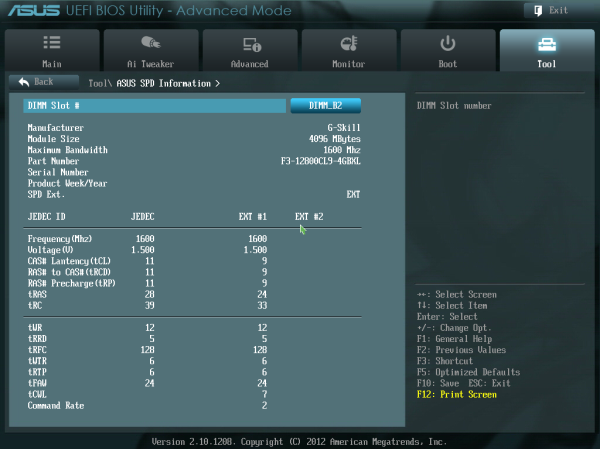








114 Comments
View All Comments
crackedwiseman - Thursday, October 18, 2012 - link
OK, just one question: why in the hell are the IGP memory tests done on an i7? The results would be much more meaningful if the tests were on an AMD A10 or similar - it has a beefier IGP, and thus would be more bandwidth-bound.creed3020 - Thursday, October 18, 2012 - link
100% Agree. Doing these tests against a Trinity APU would have been much more interesting from a iGPU point of view. It it well known that AMD APUs benefit from increased memory bandwidth, AT has yet to test Trinity for this yet they did it for Llano.silverblue - Thursday, October 18, 2012 - link
It makes sense to test; HD 4000 is far superior to HD 3000 and it is worth knowing if that extra power is bandwidth limited. Generally, it is a little, though nowhere near as much as AMD's equivalents are.JonnyDough - Monday, October 22, 2012 - link
Not to mention, it's surprising to me that AMD wasn't mentioned as a company trying to match memory to motherboard. AMD started making their own memory modules, an interesting fact I think.SeanJ76 - Saturday, June 21, 2014 - link
AMD is a decade behind Intel, in processor technology and instructions, it really doesn't matter what AMD attempts to do....SeanJ76 - Saturday, June 21, 2014 - link
No one gives a shit about APU you moron......these are desktop tests!hp79 - Thursday, October 18, 2012 - link
Maybe because more people use intel? I agree that it would have stood out more if it was AMD's IGP, but doing the test on intel IGP is also okay and gives an idea of what to expect. I think the article is fine. Besides, do people really play games with IGP? If I am playing demanding games, I want the frame rates to be minimum 60 fps. That's why I use a dedicated graphics card. This might change when AMD's IGP gets even more powerful, but for now I think it's still not there yet.zcat - Thursday, October 18, 2012 - link
> Besides, do people really play games with IGP?Some of us do. My miniitx i7 is primarily for work & everyday use, but its HD4000 is fast enough for Portal 2 and Diablo 3 to be very playable @ 1920x1080p with AA off.
However, I know the limits of IGP, and intend on upgrading to an overclocked GeForce GTX 650 Ti very soon in order to play some more demanding games this winter.
sking.tech - Monday, October 22, 2012 - link
you may want to reconsider your choice of video "upgrade"nvidia's 2nd number is more significant than the first as far as overall gaming graphics power goes... You'd do better going for a 560 TI than a 650 for approx the same cost
Dirk Broer - Wednesday, July 24, 2013 - link
You should first look at what chip actually powers the card -and it's capabilities- before staring yourself blind on the last two digits. Besides that, a GTX 560 Ti is more expensive than a GTX 650.